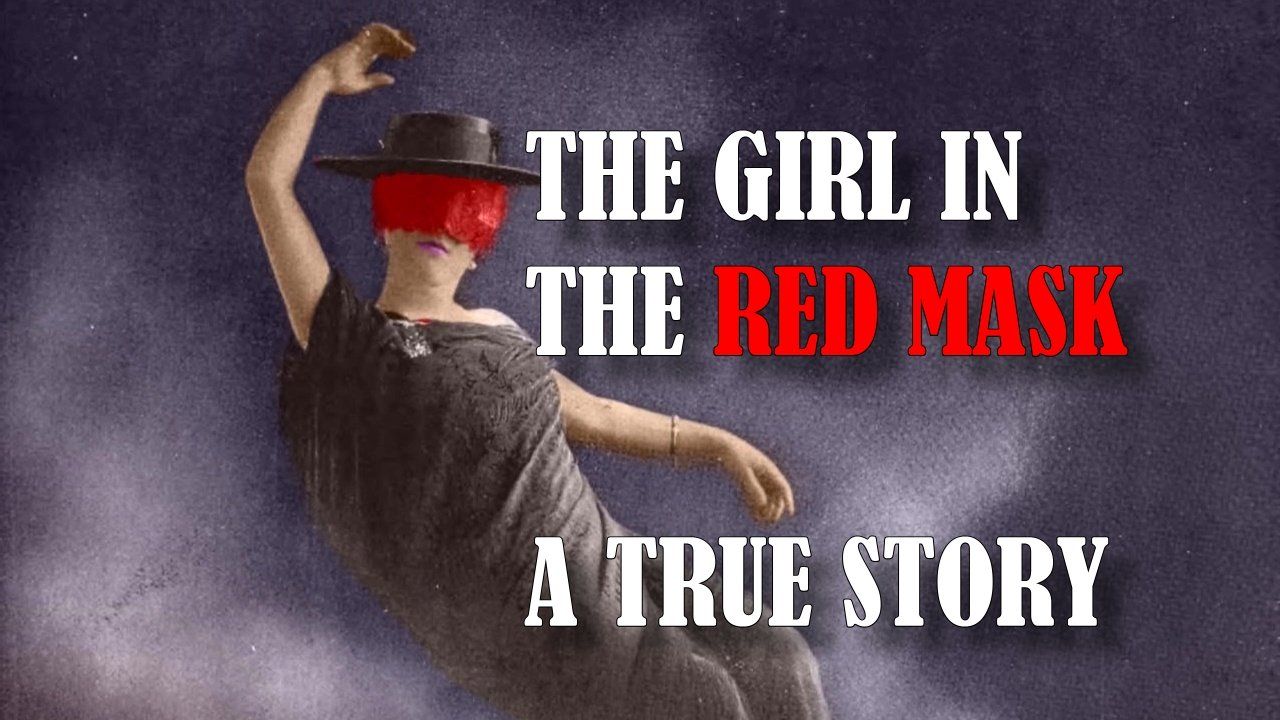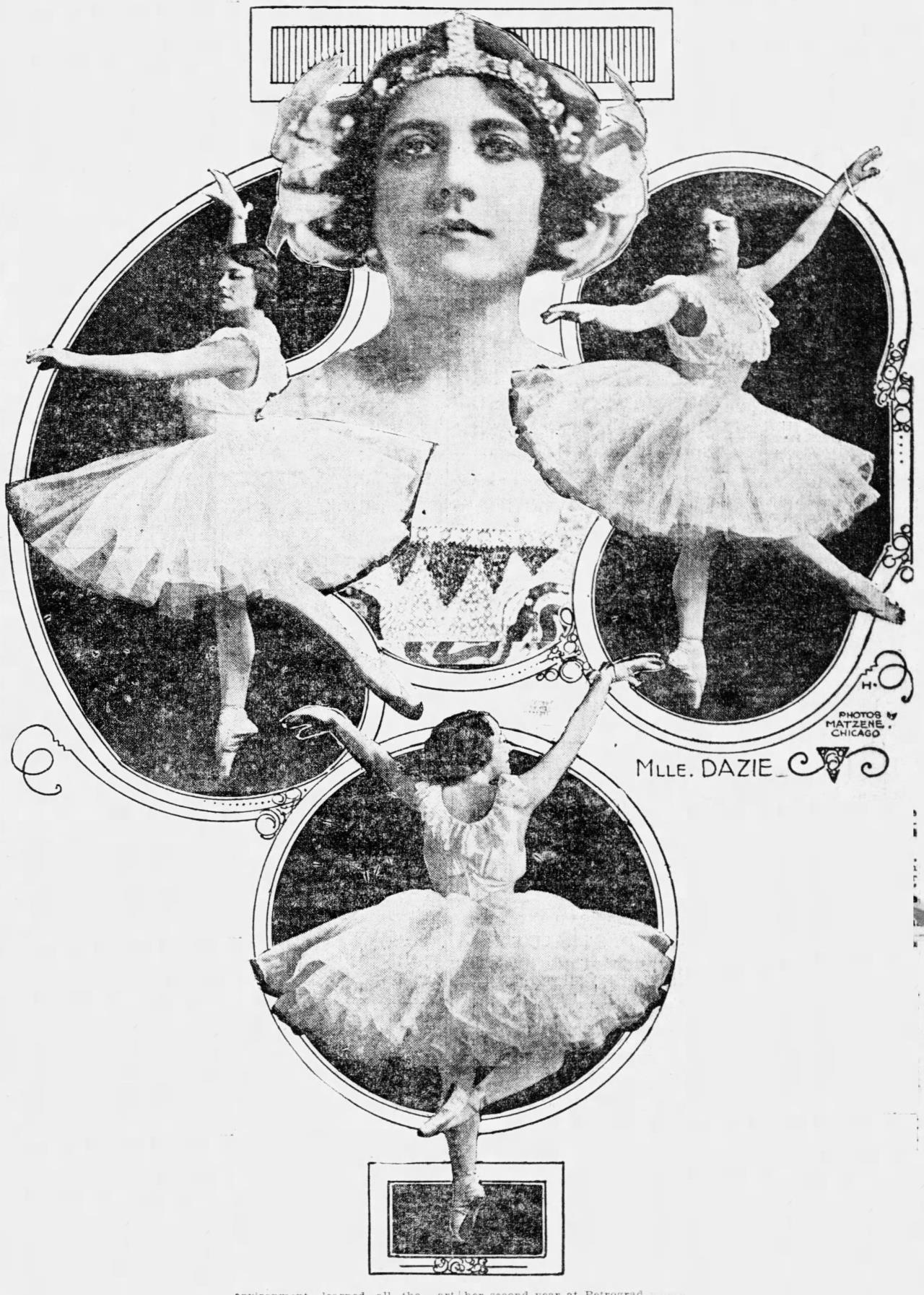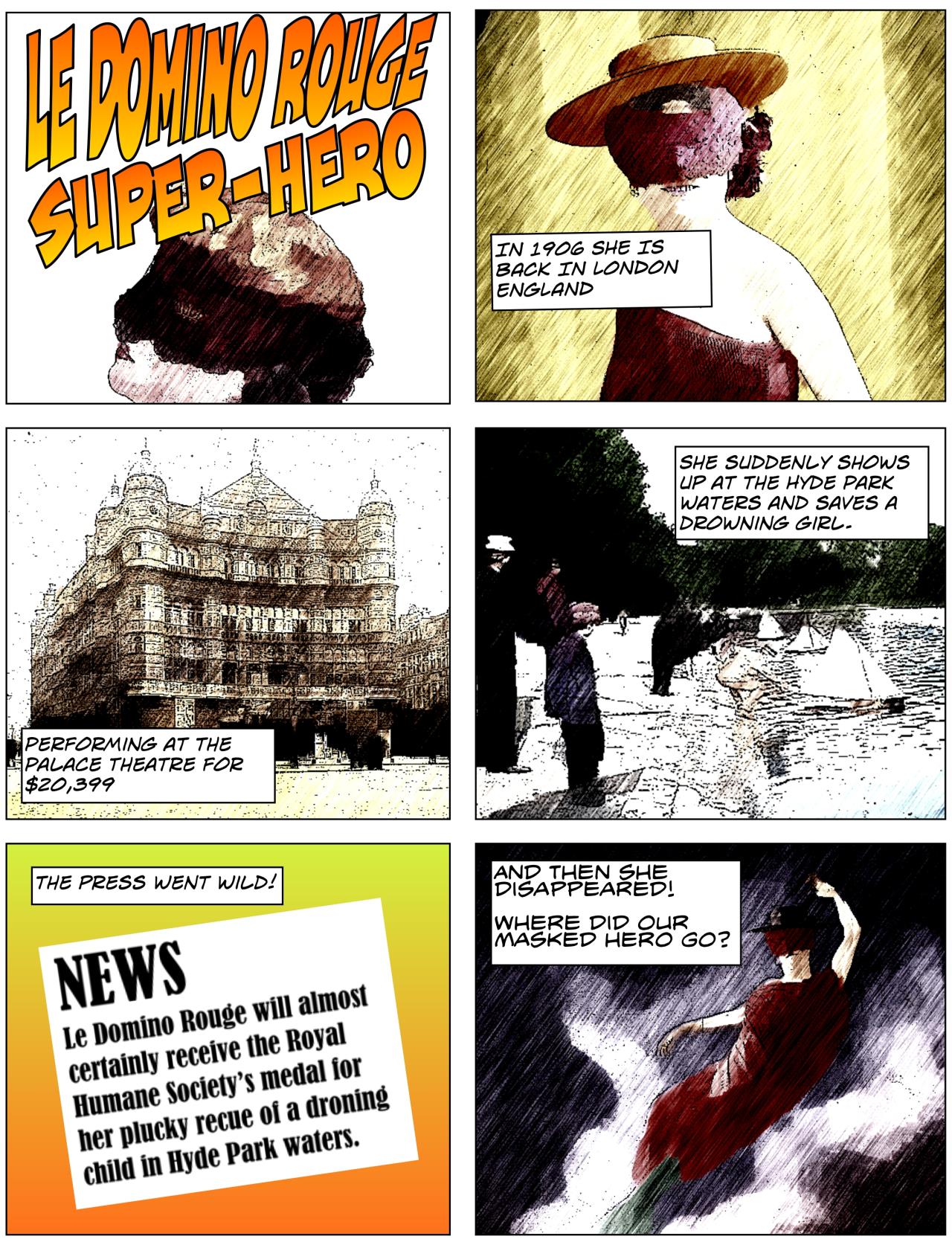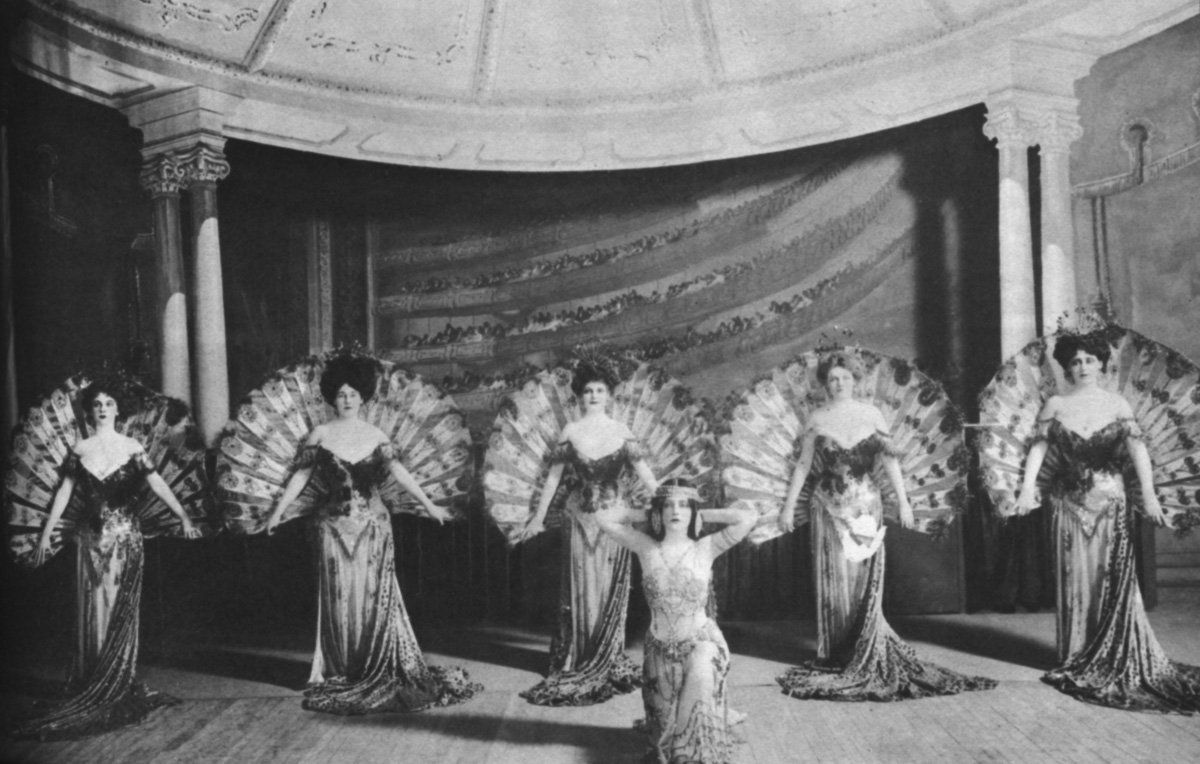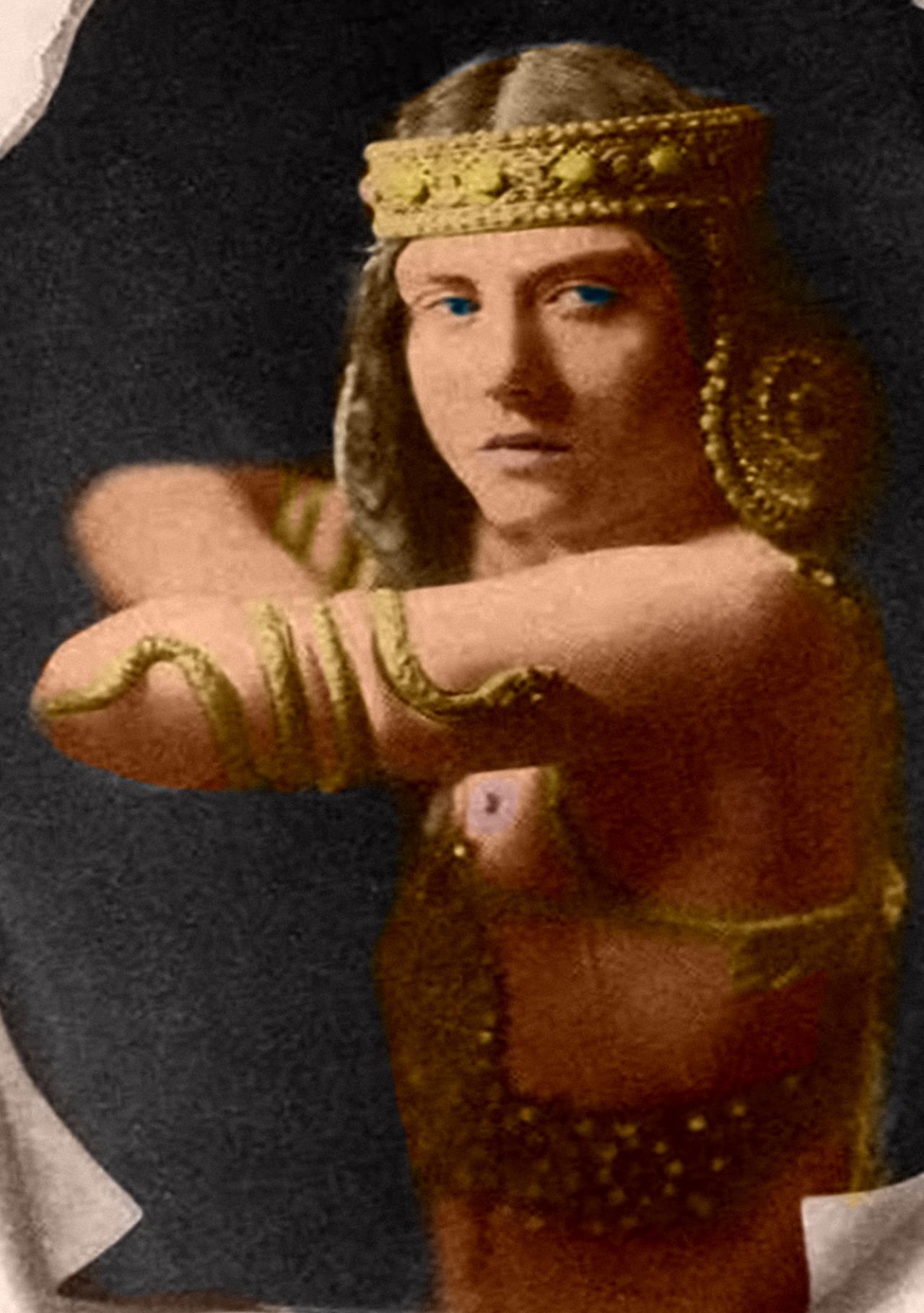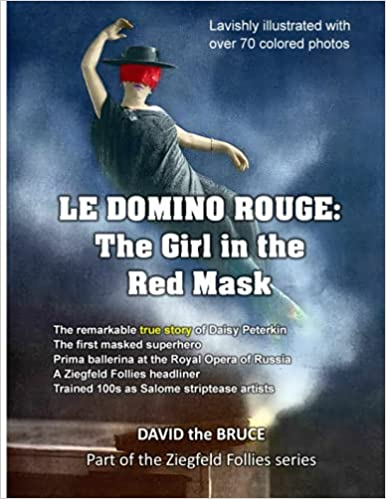MADEMOISELLE DAZIE: The Masked Superhero
The Ziegfeld Follies: The Girl in the Red Mask
DAISY PETERKIN, THE MASKED SUPERHERO
She was a world-class ballerina, known as the Le Domino Rouge, the Girl in the Red Mask, who, for a time, never revealed her true identity. Le Domino Rouge was an international sensation, becoming a masked superhero when she saved a little girl from drowning.
Theatre Magazine reported the sensational appearance of the dancer Le Domino Rouge. “This mysterious lady was first heard of in London, where she appeared in hotels and cafes beautifully dressed, but wearing always and everywhere a red mask. Every possible effort was made to force her to reveal her identity but without success. The only words that she would ever say were: ‘I am soon going to America.’ This statement was cabled across to the United States, and people began immediately to take an interest in Le Domino Rogue… Finally, the mysterious lady landed in America.” [i]
She was a sensation. People flocked to her performances. Adjusted for inflation, she was pulling in $55,998.00 weekly at the height of her tour. [ii]
Finally, she
appeared at the Weber and Field Music Hall where she unmasked revealing herself
as an American girl from Detroit, Daisy Peterkin, aka Mademoiselle Dazie.
Explaining her life journey, she said, “While I have danced ever since childhood, imitating every new step I saw. It wasn’t until I was a well-grown girl of 14 that I decided to make stage dancing my profession and I picked the most difficult style of all as my specialty. So, I started in to learn toe dancing, but it was only dogged determination to succeed that kept me at it.” [iii]
She called her style of dance as “Tripping lightly on her toes,” She stated, “It took me 3 years of hard persistent practicing to enable me to do that ‘trip’ without pained expressions indicating that it was anything but ‘light’ and pleasant… I look back upon those three years of training as one long, terrible nightmare. But my dream came true, for my first appearance was a sensational success… for the past three years, I toured all over Europe, triumphing over the terpsichorean [dance] traditions of the ballet master as the only American dancer who ever excelled them in their own field” [iv]
As a young teenager, her role models were famed dancers Isadora Duncan and Ruth St. Denis. She was self-taught and performed in local vaudeville houses, taking the show name “La Belle Dazie.”
She was no stranger to vaudeville, because when she was eight her Father moved the family from St. Louis, were she was born, to Detroit to manage candy franchises in vaudeville theaters. [v] She danced in regional vaudeville theatres, and notably, appeared at Hopkins' Theatre in Chicago in 1899 and as La Belle Dazie at the Casino in New York in 1901. She earned good money.
In 1901 at the age of seventeen, and able to afford the trip, she went abroad to study classical ballet and joined the Court ballet one year after arriving. And was made Secunda ballerina in her second season in the Royal Opera of Russia. [vi] After this Dazie appeared in unique dancing specialties in the leading music halls of London, Paris, Berlin, Breslau, Vienna, Budapest and Hamburg. [vii]
She was the first American to distinguish herself in classical ballet. And if this was not enough she mastered Jujutsu and later incorporated it into her dance. [viii]
One of her dance teachers was the legendary Lois Fuller, a pioneer of both modern dance and theatrical lighting techniques. Fuller also helped the famous dancer Isadora Duncan ignite her European career in 1902. Influenced by Fuller, Dazie merged modern dance with ballet and made use of colored stage lights into her act. One reviewer commented that she was “one of the most remarkable toe dancers ever seen.” [ix]
In 1904 she returned to America for a tour of ten weeks over the Keith vaudeville circuit. During that season she accepted an engagement at the Wisteria Grove in New York, under the direction of mega-show producers Louis F. Werba and Mark A. Luescher. Werba and Luescher were a premier production team. [x]
Mark A. Luescher was smitten by Dazie and became her personal manager. They became an item. Together they cooked up the most amazing promotion scheme ever. Daisy Peterkin, aka La Belle Dazie, would take on still another identity. She would travel back to Europe where she would wear a red mask, keeping her identity secret and announce herself as the “Le Domino Rouge” which is French for “The Girl in the Red Mask.” She would grant no interviews and say only “I am soon going to America” in broken English with a Russian accent. And off to Europe, she went to assume her new persona.
The PR stunt worked and became legendary. It was at the Folies Bergere in Paris, that she first appeared as Le Domino Rouge and danced masked, claiming that the glare of the footlights to be too painful to her eyes. [xi] “Le Domino Rouge” appeared everywhere, in cafes, hotels, and theatres, known only as Le Domino Rouge. Amazingly, no one connected “La Belle Dazie” with “Le Domino Rouge”. Instead, rumors had it that “Le Domino Rouge” was of noble birth due to the suggestive golden coronet embroidered on the right side of her red mask. [xii] Some suggesting she needed to keep her noble birth a secret. [xiii]
Music halls tried to put her under contract. But she refused, of course, because it was all a promotional stunt designed to create interest in her upcoming America tour. [xiv] The international press could not get enough of her.
Interesting side note: The Scarlet Pimpernel (1905) is the first novel to feature a masked superhero. Hard to say who was first. But Le Domino Rouge was the first live masked hero, male or female. [xv]
She returned to America in 1905 as “Le Domino Rouge” and created a sensation. Keeping her identity, a secret. Even on the White Star ocean liner during her trip to America she was identified on the passenger list as only “Le Domino Rouge.” [xvi] So popular she had become that the press was there at the dock when she arrived. She was the first passenger to come down the gangplank, she, of course, had her red mask on, followed by her attending maid. She made her way to an automobile and was whisked away never saying a word to the press. When the Press interviewed the other passengers, they learned she always had the mask on and seldom spoke. A total mystery. [xvii] The press was hooked.
People began reporting spotting her in restaurants, hotels, theaters, and even a church service on New York’s fashionable 5th Avenue. But, always wearing her red mask. [xviii]
The reviews of her shows were stellar. Performing at the Paradise Roof Garden and the Wisteria Grove, she was described by one reviewer as a “dancing devil” from Paris whose “manner is original and eccentric… She makes you wonder if she ever walks flat-footed… the tips of her toes are all she uses” [xix]
Just a side note here. During these performances, Dazie appeared with a young sixteen-year-old Elsie Janis, who would later become very important and popular in the Ziegfeld Follie. [xx] Elsie was prepped by Dazie’s husband, Mark A. Luescher. But, more on this in a later chapter.
Le Domino Rouge performed in the dance halls and vaudeville stages with a red mask over her face. Her top-notch dancing coupled with the mystery of who she was created a publicity bonanza. She was the talk of the town.
Venues, where she performed, would distribute souvenir postcards days before her performance. Poli’s Theatre handed out thousands of promotional cards. [xxi]
No vaudeville act in New York had been so well advertised. [xxii]
And here is what made her a superhero. In 1906 she was back in London performing at the Palace Theatre for $750 a week (that would be $20,399 in today’s dollar). She suddenly showed up at the Hyde Park waters and saved a drowning girl. The newspapers went wild over “the girl in the red mask” who jumped into the waters and saved a little girl from certain death. The Royal Humane Society medal was being considered for the masked unnamed hero woman. However, after the heroic act, she was nowhere to be found. She was staying at the Hyde Park Hotel, but she was not there. [xxiii]
On September 9, 1906, Le Domino Rouge was finally found lying unconscious. She had been poisoned by “a chronic form of ptomaine poisoning” (i.e. food poisoning). [xxiv] But just how did this happen? Lying unconscious for an entire day is seriousness, and perhaps due in part to a health issue she had. Her health issues would resurface later when she gets stabbed in the chest with a knife. More on this later. At that time, nothing more was said of the food poisoning, nor of her unconscious state. Being the determined person, she was, she just moved on.
She said she wore the face mask because stage lights bothered her eyes. She would place a cloth over her face when training with Lois Fuller and her bright stage lights. She spoke of getting so overcome by the stage lights she would nearly pass out (again, her health issue). But more than this, her manager, Mark Luescher, whom she would later marry in 1906, thought the face mask was a great PR tool, and it certainly was. But the origin of the mask comes from her sensitivity to strong lights. She literally took a weakness and turned it into a strength.
The mask was red, and it was claimed to be completely opaque. Her managers insisted she was dancing sightless. [xxv]
By the end of 1906, she finally revealed herself as Mademoiselle Dazie. Her unmasking came at Weber’s Theatre in New York in late 1906 to a packed house. It had been announced on every billboard all over town. [xxvi]
She had a new stage name. The former La Belle Dazie was now Mademoiselle Dazie (Mlle Dazie). [xxvii] A new name that had been suggested by her manager/husband Mark Luescher.
The renowned Broadway producer Oscar Hammerstein immediately contracted her as his premiere dancer. This show was a high honor for her. Mademoiselle Dazie was a popular sensation for Hammerstein.
Her success was “spectacular and unprecedented as few toe dancers have ever established a vogue in America” [xxviii] ( New York Telegraph, 16 July 1906 )
Meanwhile, Florenz Ziegfeld was putting together a new show called “Follies of 1907” and he needed headliners to assure the show's success. He was drawn to the immensely popular Mademoiselle Dazie. She and others like Nora Bayes, Grace LaRue, and Annabelle Whitford were all contracted to be his dream team. Well, that and the 50 Anna Held Girls, soon to be known as the Ziegfeld Follies. But Dazie was the “chief attraction.” [xxix]
The first ever Follie’s was a smashing hit in New York and it was soon on the road to such places as Washington DC, Boston, and Chicago. And Mademoiselle Dazie was always headlined.
Always looking for fresh ways to present dance, Mademoiselle Dazie introduced a Jiu-Jitsu Waltz. Just exactly how she combined classic dance and the martial arts has been lost to history. But there on the Ziegfeld stage, she was performing jiu-jitsu as a dance. [xxx] Very unique and most unusual. But, it wasn’t as eye-catching as her Salome.
The show would end with Mademoiselles Dazie playing Salome doing the Dance of the Seven Veils and the audience would go wild. [xxxi]
What was the Dance of the Seven Veils you might ask? Well, this is a very interesting story. Basically, it was a striptease. It was a reenactment of a scene from the Bible. Striptease in the Bible? Well, yes, or at least Oscar Wilde’s version of it in his wildly popular play entitle Salome.
In the Bible book of St. Mathew, chapter 14, the daughter of Herodias danced so seductively before King Herod that he offered her anything she wanted. She requested the head of John the Baptist. Though the Bible does not name the daughter of Herodias as Salome, the Jewish historian Josephus does.
Artists through the years have artistically imagined what this seductive dance might have looked like. In so doing Salome became a symbol of a dangerous female seductress. Oscar Wilde wrote his take of Salome in his 1896 play which includes his Dance of the Seven Veils, and it was promptly banned in London. Later it was combined with the music of Richard Strauss which premiered in Dresden, Germany in 1905, and it was off and running. Salome dressed only in the Seven Veils would strip them off slowly during the dance until she had nothing more on. Lois Fuller, Dazie’s teacher, was the first solo dancer to present a Salome piece.
Being the turn of the century, Salome had a particular meaning. to the emerging new woman who was taking control of her own sexuality and breaking from the subjugation to men. Here in Salome was an independent sexual woman demanding the head of a man. The symbolism spoke to myriads of women. Salomania was born. Women everywhere were wanting to perform the part of Salome. You might say Salomania was part of the turn of the century feminist movement.
Salomania was also the beginning of modern striptease, where veils and clothes are slowly removed in time to the music. It’s crazy to think perhaps, but modern striptease was sparked by a Bible story.
Salome was Ziegfeld’s most successful act in his “Follies of 1907” and Mademoiselle Dazie was the one who performed it. The staging was based on Audrey Beardsley’s famous illustrations appearing in Oscar Wilds published play.
As Dazie would perform the Salome Seven Veils Dance, the police would arrive, and arrest Dazie as the Follies burst out in the Can-Can dance. It was all staged of course. And what a great closing act it was. The audiences loved it. No wonder it was the most popular act in the 1907 Follies show.
THE REST OF THE STORY IS IN MY NEWLY PUBLISHED BOOK AVAILABLE ON AMAZON
LE DOMINO ROUGE: The Girl in the Red Mask:
The First Masked Superhero
Large 8.5 x 11 pages with over 70 full color photos on high quality paper
Or on KINDLE instant download at $2.99
_____________
References
[i] Theatre Magazine. New York. November 1920. Page 322
[iii] The Decatur Herald, Sunday, February 19, 1905
[iv] The Decatur Herald, Sunday, February 19, 1905
[v] Ziegfeld, Richard and Paulette, Harry N. Abrams, New York, 1993. The Ziegfeld Touch: The Life and times of Florenz Ziegfeld. Page 290
[vi] Detroit Free Press. Sunday November 7, 1909
[vii] Who's who on the stage: 1908 the dramatic reference. Page 120
[viii] Detroit Free Press. Sunday November 7, 1909
[ix] The Topeka State Journal., February 16, 1905 The Belle of New York, Page 2
[x] Who's who on the stage: 1908 the dramatic reference. Page 120
[xii] The Topeka Daily Capital, June 04, 1905, Page 1
[xiii] The Sedalia Democrat, Thursday, June 8, 1905
[xiv] The Sedalia Democrat, Thursday, June 8, 1905
[xvi] The Topeka Daily Capital, June 04, 1905, Page 1
[xvii] The Boston Globe, Thursday June 8, 1905
[xviii] The Courier Journal, Kentucky, Sunday, August 6, 1905
[xix] The Courier Journal, Kentucky, Sunday, August 6, 1905
[xx] The Courier Journal, Kentucky, Sunday, August 6, 1905
[xx]The Decatur Herald, Sunday, February 19, 1905
[xxi] Hartford Courant, Saturday, January 20, 1906
[xxii] Pittsburgh Daily Post, Sunday, December 8, 1907
[xxiii] Buffalo Courier, Sunday, September 9, 1906
[xxiv] The Pittsburgh Press, Sunday, September 9, 1906
[xxv] New York Evening World, 14 July 1907
[xxvi] Pittsburgh Daily Post, Sunday, December 8, 1907
[xxvii] The Boston Globe, Tuesday, October 16, 1906
[xxviii] New York Telegraph, July 16, 1906
[xxix] The Buffalo Sunday Morning News. Sunday September 5, 1909
[xxx] van der Merwe, Ann Ommen. The Ziegfeld Follies A History in Song. Scarecrow Press, 2012. Page 16
[xxxi] van der Merwe, Ann Ommen. The Ziegfeld Follies A History in Song. Scarecrow Press 2012. Page 11

